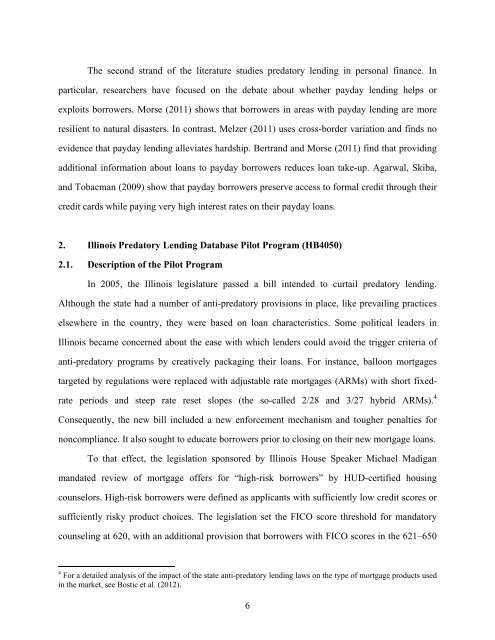Create successful ePaper yourself
Turn your PDF publications into a flip-book with our unique Google optimized e-Paper software.
The second strand of the literature studies predatory lending in personal finance. In<br />
particular, researchers have focused on the debate about whether payday lending helps or<br />
exploits borrowers. Morse (2011) shows that borrowers in areas with payday lending are more<br />
resilient to natural disasters. In contrast, Melzer (2011) uses cross-border variation and finds no<br />
evidence that payday lending alleviates hardship. Bertrand and Morse (2011) find that providing<br />
additional information about loans to payday borrowers reduces loan take-up. Agarwal, Skiba,<br />
and Tobacman (2009) show that payday borrowers preserve access to formal credit through their<br />
credit cards while paying very high interest rates on their payday loans.<br />
2. Illinois <strong>Predatory</strong> <strong>Lending</strong> Database Pilot Program (HB4050)<br />
2.1. Description of the Pilot Program<br />
In 2005, the Illinois legislature passed a bill intended to curtail predatory lending.<br />
Although the state had a number of anti-predatory provisions in place, like prevailing practices<br />
elsewhere in the country, they were based on loan characteristics. Some political leaders in<br />
Illinois became concerned about the ease with which lenders could avoid the trigger criteria of<br />
anti-predatory programs by creatively packaging their loans. For instance, balloon mortgages<br />
targeted by regulations were replaced with adjustable rate mortgages (ARMs) with short fixedrate<br />
periods and steep rate reset slopes (the so-called 2/28 and 3/27 hybrid ARMs). 4<br />
Consequently, the new bill included a new enforcement mechanism and tougher penalties for<br />
noncompliance. It also sought to educate borrowers prior to closing on their new mortgage loans.<br />
To that effect, the legislation sponsored by Illinois House Speaker Michael Madigan<br />
mandated review of mortgage offers for “high-risk borrowers” by HUD-certified housing<br />
counselors. High-risk borrowers were defined as applicants with sufficiently low credit scores or<br />
sufficiently risky product choices. The legislation set the FICO score threshold for mandatory<br />
counseling at 620, with an additional provision that borrowers with FICO scores in the 621–650<br />
4 For a detailed analysis of the impact of the state anti-predatory lending laws on the type of mortgage products used<br />
in the market, see Bostic et al. (2012).<br />
6

















